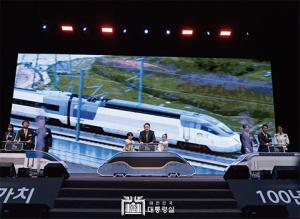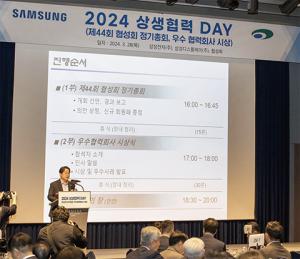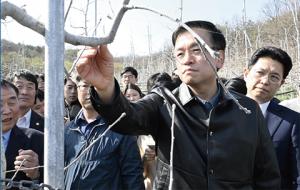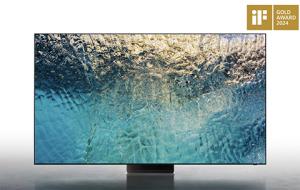 |
문장학습 원리로 천자문을 1주일 만에 마스터하는 신기술
“영어에 파닉스가 있다면, 한자에는 ‘5분 천자문’이 있다”
한자교육연수원 전제웅 원장
2018년 교육부의 새 교육과정 개편안에 한자 병기가 본격 공론화되었다. 한자 교육은 1948년 한글날부터 제정된 한글전용 공용문서 법률로 주춤하다가, 1976년부터 시행된 국·한문 병용과 초등학교 창의체험활동 과목에 한자가 포함되며 부활했다. 이후 한자 교육은 정서 함양과 어휘력 증대에 기여하며, 중국어 교육에도 필수적이라 효율적인 학습법이 꾸준히 요구되어 왔다. 따라서 가장 빠르게 외우고 잊어버리지 않는 학습법을 필두로 한 한자교육연수원 전제웅 원장으로부터 한자 습득의 새로운 왕도를 알아본다.
25년의 노하우가 담긴 한자교육, ‘5분에 읽는 천자문’
한자의 수요 증가로 사교육이 성행하는 중에, 한자 표기를 찬성하든 반대하든 모든 이들이 공감하는 부분이 있다. 그것은 여느 언어 중에서도 표음문자인 한자는 외우기 까다롭고 돌아서면 잊기 쉽다는 점이다. 더욱이 우리말 어휘의 70%가 한자어로 되어 있으며, 그 어휘의 90%는 동음이의어이므로 오역을 막기 위해서 한자의 필요성이 대두되는 것이다. 이 점에서 남들과는 다른 대입 논술과 취직용 자소서를 위해서는 한자와 한자어의 올바른 쓰임을 익히는 것이 대세가 되었다. 그래서 한자의 필요성을 논하기보다는 점차 “어떻게 한자와 친숙해지고, 가능한 적은 시간을 투자하여 최대한 암기하는가”에 관심이 쏠리고 있다. 한자교육연수원의 전제웅 원장은 25년 간 한자를 연구한 끝에, 한자를 획으로 쓰면서 글자 하나씩을 외우는 방식보다는 문장으로 이어 자연스럽게 보고 읽으며 머릿속으로 들어오는 개념을 정립했다. 전 원장은 독서가 가능한 6세 어린이도 해내는 한자 문장읽기 방식이 소실됨을 안타깝게 생각하고, 읽어내는 능력을 함양하는 동시에 배운 것을 잊어버리지 않는 방법을 제시했다. 전 원장은 음과 뜻을 큰 소리로 낭독하여 암기하는 조선시대 서당 어린이들보다 빠르게 외울 수 있는 학습법을 가르치고 있으며, 이 방식에 따라 공부한 수강생들은 한자 1,000자를 5분 내로 읽어낸다. 또 가장 많이 사용되는 기본 한자의 300자를 익히면 사실상 한자의 10,000자를 읽을 수 있게 된다. 전 원장의 ‘5분에 읽는 천자문’은 천자문, 국한문한자성경을 바탕으로 구성되어 있다. 이 중 천자문에서 문장 읽기를 10개 단원으로 나누어 읽는 연습을 시켜, 실험교육에 참여한 100명의 수강생들이 연령에 상관없이 한 달 만에 모두 천자문을 5분에 읽어낸 것이다.
쉽고 효율적인, 새로운 한자교육법의 성공사례로 일자리 창출에도 기여
수많은 교재 중에서 오로지 한자교육서만 단어도 문장도 아닌 단순암기 형태 교재로만 출간됨을 아쉬워한 전 원장은, 문장을 읽으며 그 문장 속의 단어를 이해하는 방식으로 과정을 짰다고 한다. “한자의 교재인 천자문은 중국의 역사 입문서이자, 각 시대의 나라와 인물, 지명과 표기법을 담고 있는 일종의 이야기 교재이다. 그래서 내용에 따라 10과로 나누게 되었고, 반드시 1과부터 시작할 필요는 없다. 사람에 따라 일주일도 가능하며, 넉넉잡아 하루 1시간에 1과씩 공부하면 10일 정도 걸린다” 한글로는 똑같이 발음되는 한자가 많으므로, 우선 천자문을 5분 안에 읽을 수 있게 한 뒤, 다음 단계로 넘어간다. “처음에는 낯설더라도 반복하여 100번 정도 읽으면, 소요시간이 줄어들면서 더 빠르게 읽어낸다. 먼저 음을 읽어내고 난 후 한자의 뜻을 조합하며, 한 음당 가장 많이 쓰이는 한자 중심으로 읽어내면 웬만한 한자는 다 읽을 수 있다” 전 원장의 한자 문장 읽기법 과정은, 천자문으로는 한자를 익히는 기초를 닦고, 다음에는 한자를 익힌 뒤 잊지 않는 원리가 적용된 한자성경으로 한자의 읽기를 완성하는 과정을 거친다. “한자성경에는 창세기 1-3장과 천자문의 처음 11문장 88자와 일맥상통하는 점이 있다. 그리고 서로 다른 글자가 이어지는 천자문과 달리 한자성경은 같은 글자가 나오므로, 반복하여 읽다 보면 뜻과 용어를 알게 되며 외우지 않아도 머릿속에 남게 된다” 전 원장의 방식대로 한자를 읽게 되면 집중력이 향상되며, 어휘력 향상은 여기서 얻는 귀중한 덤이다. 따라서 단기간에 익혀도 학생들의 성적 향상에 도움이 되며, 전 원장의 천자문 문장읽기, 천자문지도자과정을 모두 이수한 이들은 일반교양을 넓힐 한자교실 및 강사로도 활동할 수 있다.
한자문맹률을 낮추는 교육은 물론 중국어 습득에도 유리해
13,16,17대 총선에 출마하며 정치계에 몸담았고, 현재 벤처창업지도자양성 교육과정에 참여하고 있는 전 원장은 한자 교육의 대중화에도 열의를 보이고 있다. 서울, 인천, 부천을 주 무대로 활동하며 교육 중인 전 원장은 그간 고교 졸업자들과 대학생들의 한자 문맹률이 높아져 감을 우려하고, 한자교육과정에서 효율성이 떨어지는 사교육의 성행을 접하며 교육의 질을 개선하고자 노력해 왔다. 천자문 문장읽기의 수료 기준은, 5-10분에 읽을 수 있는 사람에 한해 연수교육의 1,2차 수료자격을 준다. 그리고 지도자과정은 교재의 1-10과를 모두 읽어내고 자신이 배운 것을 2명 이상에게 읽기 지도를 해 낸 사람들만 수료할 수 있다. 교재는 원문 출처에 대한 호기심을 다음에 나오는 천자문주해로 심화하여 흥미를 유발한다. 전 원장은 한자에서 필수적인 부수자, 한글로 음독되는 한자의 뜻과 인명, 지명, 나라, 그리고 유사어보다는 반대어 중심인 한자의 언어적 속성과 독립문자, 기본자 등의 뜻과 읽기, 쓰기를 익히게 한다. 이렇게 배우면 중국어를 읽는 방법도 터득할 수 있어, 중국어를 배울 때도 유익하다. 예를 들면, 한자의 음은 전체를 다 합해도 한글로 총 450여 자에 불과하다. 중국어에 많은 간체자는 원래 천자문 기준으로 40% 내외이다. 때문에 이것을 중국어 독음으로 옮기면 뜻이 다른 한자가 한 음 당 한 가지 발음이 되는 관계로 성조만 극복하면 중국어 읽기가 더 쉽다는 것이다. 전 원장이 연구한 한자를 기본자 300여 자로 만(萬)자를 읽는 원리처럼 중국어는 그보다 훨씬 적은 음만 병음으로 익히면 중국어 읽기를 쉽게 익힐 수 있게 된다.
전 원장의 바람은 이러한 학습법으로 부모가 아이들에게 천자문을 가르치고, 한자와 중국어를 많은 사람들이 한글처럼 익혀 응용하게 되는 것이다. “한자는 음과 뜻 모두 우리말의 일부이다. 그래서 우리말 속 한자는 단어의 조합 형태를 읽기만 해도 그 뜻을 저절로 알게 된다” ‘5분에 읽는 천자문’은 전 원장의 목회자로서의 신념과 지식인의 연구가 결합된 창조적인 교육법이다. 이렇듯 한글의 본질에 다가가고 정확하게 구사하는 데서 경쟁력을 얻는 시대에, 언어의 세계화는 생각 외로 가까운 곳에 있음을 역설하는 전 원장의 교육자로서의 자세가 돋보인다.
New technique that masters the Thousand-Character Classic in a week
"If there's Phonics for English, there's '5 Minute Chunjamoon' for Chinese characters"
Educational Institute for Chinese Characters CEO Jewoong Jeon
Reding the Thousand-Character Classic in 5 minutes
Whether you agree to keep using Chinese characters or not in our lives, there are certain things which we all agree. It is difficult to learn as it is phonogram but 70% of the Korean language is consisted of the characters with 90% of it as homonym and this is the reason we need to keep the characters. In that terms, it is important to learn both characters if you wish to make an impressive CV or a letter of self-introduction. The focus now is turning to how effectively we learn it rather than we need it or not. Educational Institute for Chinese Characters CEO Jewoong Jeon has studied Chinese characters for 25 years and concluded that it is better to read and understand in a sentence than to memorize the word one by one. Jeon regretted the fact that some of the reading methods were disappearing and he suggested a new effective method instead. Those students who studied with Jeon's method can read the Thousand-Character Classic in 5 minutes. And if you learn the 300 basic Chinese characters you can actually be able to read 10,000 characters. Jeon's '5 Minute Chunjamoon' is made based on the Thousand-Character Classic and Korean-Chinese bible. Jeon divides the Thousand-Character Classic into 10 chapters to train students to read. A test participated by 100 people proved that all of them could be able to read the Thousand-Character Classic in 5 minutes after a month training.
Contributing to job creation with '5 Minute Chunjamoon'
Jeon regretted that most teaching materials for Chinese characters is made based on memorizing each word and this prompted Jeon to make a program to learn the characters in a sentence. Jeon says "the Thousand-Character Classic (TCC) contains Chinese history, each age and important personnel, and place of name and notational system. So I divided it into 10 chapters according to its subject and you don't need to start from the first chapter. It depends on a person but you can learn in a week or 10 days if you spare an hour to study one chapter each day." There are many characters which make the same sound as the Koreans so you need to learn to read it all in 5 minutes to move on to the next level. Jeon says "if you try to read it 100 times in a row you can be able to read it faster as time goes by. But you need to read the sound of the character first and then try to understand its meaning for a good result." If TCC is the basic to learn the Chinese characters, the Chinese character bible enables you to master the reading. Jeon says "Genesis 1-3 in the Chinese character bible and 88 characters of the first 11 sentences of TCC have something in common. While former one shows the same words in a row, the latter one shows different words and if you keep repeatedly reading them you will naturally know about the words and their meaning." You can also improve your concentration and vocabulary. For students, they can improve their academic records and if you master all of Jeon's courses you can even teach others.
Fantastic method to effectively acquire Chinese
Jeon built his political career through the 13th, 16th and 17th general elections and is currently involved in 'venture start-up leaders' training' and spreading Chinese character education centered around Seoul, Incheon and Bucheon. Meanwhile, Jeon provides a completion certificate of the first and second training to those who can read TCC in 5 to 10 minutes. But leader training can only be passed by those who can read all the chapters and can teach more than 2 students. The course books arise students' curiosity through annotations and they are consisted of various elements such as radicals, meaning, name of people and place, the country, linguistic properties, independent characters, and basic characters. In this way, you can learn Chinese easily as the sound of the Chinese characters are 450 in the context of the Korean language. Also, simplified Chinese characters takes only 40% in TCC. When you make these into single sounds, different meaning of each word makes one sound so that you can easily read Chinese by overcoming intonation only. It means that if you familiarize with reading Chinese by pinyin, you can easily learn Chinese. Jeon says "the sounds and the meanings of the Chinese characters are related to the Korean language. Therefore, if you can read the combination of the Chinese characters in Korean, you can naturally understand their meaning." '5 Minute Chunjamoon' is melted with Jeon's conviction and knowledge as a clergyman. Power Korea hopes that Jeon's new method will contribute to promoting Chinese characters in Korea.
정재헌 기자 jjh05220@naver.com







